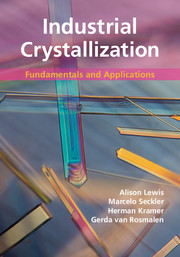Book contents
- Frontmatter
- Contents
- Nomenclature
- Industrial crystallization in practice: from process to product
- 1 Thermodynamics, crystallization methods and supersaturation
- 2 Characterization of a crystalline product
- 3 Basic process design for crystallization
- 4 Nucleation
- 5 Crystal growth
- 6 Agglomeration
- 7 The population balance equation
- 8 Batch crystallization
- 9 Measuring techniques
- 10 Industrial crystallizers
- 11 Precipitation and anti-solvent crystallization
- 12 Melt crystallization
- 13 Additives and impurities
- 14 Polymorphism
- Index
- References
6 - Agglomeration
Published online by Cambridge University Press: 05 July 2015
- Frontmatter
- Contents
- Nomenclature
- Industrial crystallization in practice: from process to product
- 1 Thermodynamics, crystallization methods and supersaturation
- 2 Characterization of a crystalline product
- 3 Basic process design for crystallization
- 4 Nucleation
- 5 Crystal growth
- 6 Agglomeration
- 7 The population balance equation
- 8 Batch crystallization
- 9 Measuring techniques
- 10 Industrial crystallizers
- 11 Precipitation and anti-solvent crystallization
- 12 Melt crystallization
- 13 Additives and impurities
- 14 Polymorphism
- Index
- References
Summary
Why this chapter is important
In the context of crystallization, agglomeration is the process in which two or more particles are brought in contact and stay together for a sufficiently long period such that a crystalline bridge between the particles can grow. Thus, a stable particle or agglomerate is formed. Particle agglomeration plays an important (and not always desirable) role in the formation of larger particles in precipitation and crystallization processes. Because of its significant effect on product quality, control over agglomeration is important for industrial crystallization (Hollander, 2002).
Figures 6.1 to 6.4 show examples of different types of agglomerates. It should be apparent from the pictures that the primary crystals that form agglomerates can be glued together in rather random ways. The agglomerates in the images lack the symmetry and the “esthetic beauty” of crystals formed due to growth. In fact, it is often the lack of symmetry that can be used to, at least qualitatively, identify the presence of agglomeration as a size enlargement process. The MgSO4 · 7H2O agglomerate in Figure 6.1 has a degree of symmetry that suggests that the individual “roses” are in fact a result of twinned growth, whilst the overall agglomerate is a consequence of the individual roses becoming agglomerated together. In contrast, both the agglomerates in Figure 6.2 have sufficiently disordered and random morphologies to be classified as true agglomerates.
In this chapter the physicochemical steps that lead to the formation of these agglomerates are described. In addition, the necessary mathematical models for describing the agglomeration process are discussed.
Agglomeration or aggregation?
A number of terms are used in literature to describe phenomena in which particles come together to form one entity. These include agglomeration, aggregation, conglomeration, coalescence, coagulation and flocculation. In this text, the convention adopted by Randolph and Larson (1988) is used.
- Type
- Chapter
- Information
- Industrial CrystallizationFundamentals and Applications, pp. 130 - 150Publisher: Cambridge University PressPrint publication year: 2015
References
- 2
- Cited by



